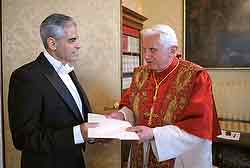How will the new U.S. Ambassador to the Vatican get along with the pontiff?
NCR’s John Allen sat down for a chat with Miguel Diaz and came away with some interesting insights:
In some ways, one could think of Díaz and Benedict XVI as a mismatched pair. In terms of his theological outlook, Díaz is a disciple of the German Jesuit Karl Rahner, of whom then-Cardinal Joseph Ratzinger once said that “we lived on different theological planets.” Though Díaz is uncomfortable with ideological labels (“I don’t ever want to be boxed in,” he said), he’s often seen as representing a broadly progressive streak in Catholicism, while Benedict is an avatar of Catholic tradition.
Beneath those surface contrasts, however, Díaz said that he and the pope actually have several things in common. Both come from humble origins, both have been significantly shaped by Benedictine spirituality, and both are theologians lifted out of the academy and into leadership roles.”We’ve both been uprooted from the university … for the sake of service,” he said. “I have a passion for theology, but I also know very clearly that I have to sacrifice that piece right now. I know the same thing is true [of Benedict] … I’m sure he would love to be doing more theology, teaching, and so on.”
Asked if a Rahnerian like Díaz could find a comfort zone in Rome, where the intellectual climate under Benedict XVI tends to be more heavily indebted to Hans Urs von Balthasar, another German-speaking 20th century theological titan. Von Balthasar’s focus was less on the intersection with the world, as in Rahner, and more on the distinctive internal culture of Christianity.
“One of the last theses I directed was on von Balthasar,” Díaz replied, saying that he particularly appreciated “the tremendous aesthetic dimension” to his thought. Openness to all perspectives, he said, is at the heart of how he sees his role: “I want to be a bridge-builder.”
There’s much more, and it’s all fascinating. Check it out.

